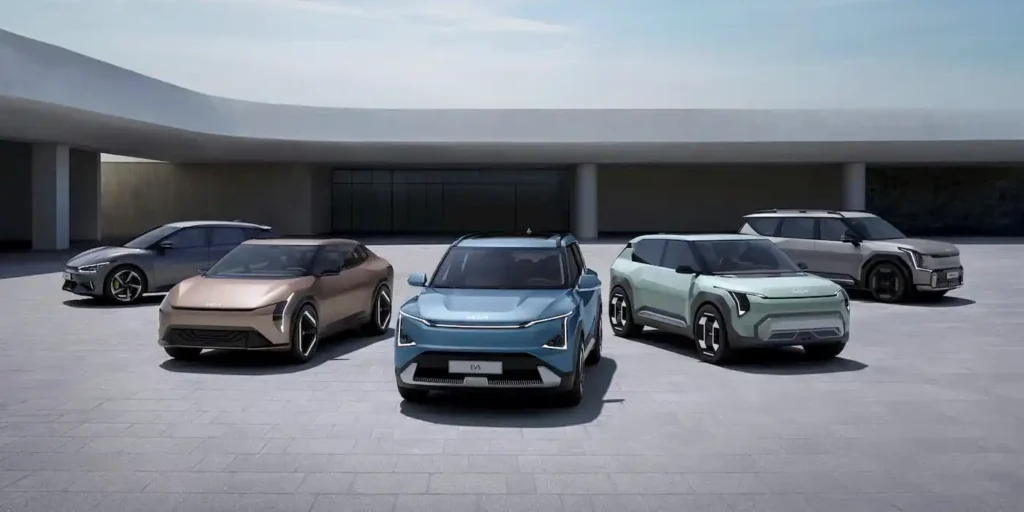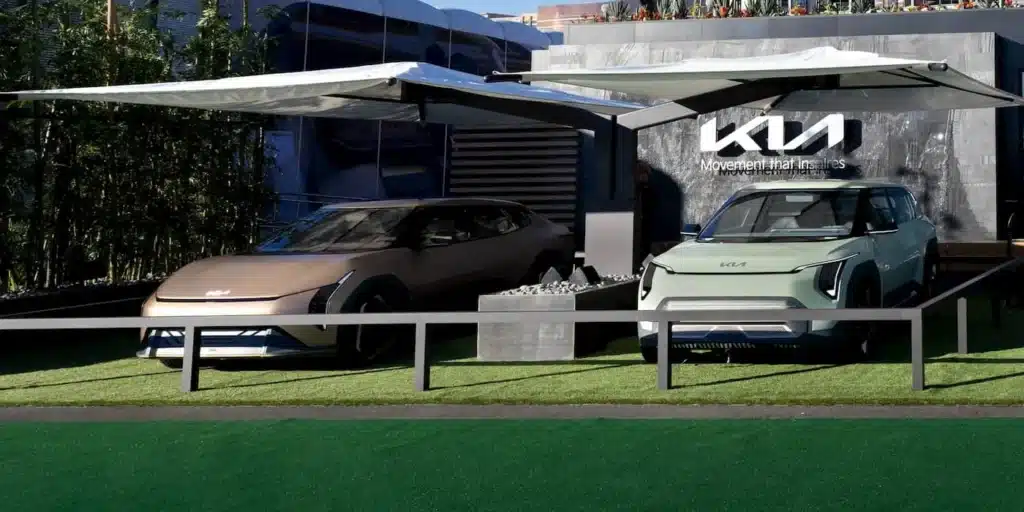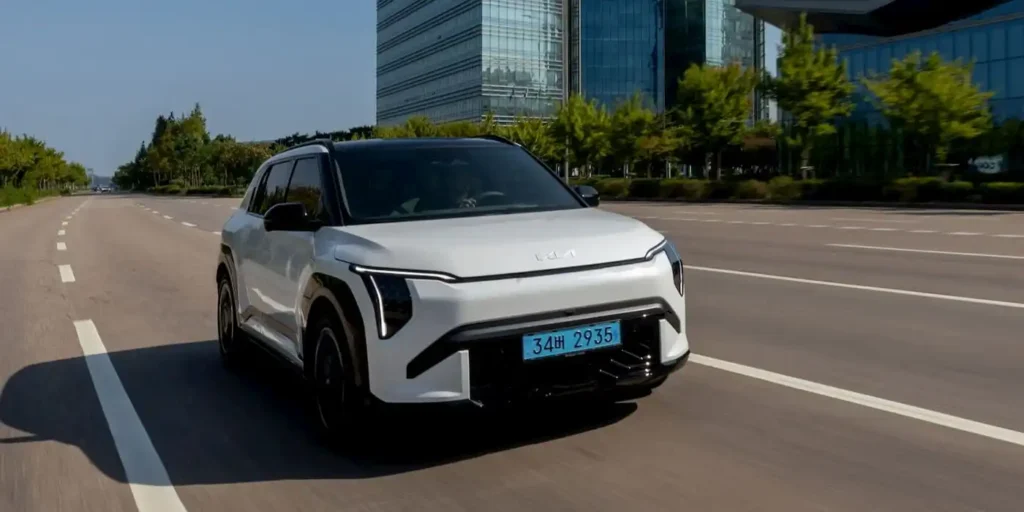Kia Plans $22K Entry-Level EV
Kia is making significant strides in the electric vehicle (EV) market by introducing a lineup of more affordable EVs. Following the success of models like the EV3, Kia plans to push the envelope even further with a new entry-level EV priced around $22,200 (€20,000), making it one of the most competitively priced EVs on the market. At the other end of the spectrum, Kia is also developing a performance-oriented EV similar to the Stinger GT.
Kia provided insights into its future EV plans during its first annual EV Day in October, where it unveiled several new low-cost concepts, including the EV3, EV4, and EV5. The EV3, in particular, has been touted as a “game-changer” for the brand. After launching pre-orders in Korea for the EV3 in June 2023, starting at $30,700 (KRW 42.08 million), the compact electric SUV quickly gained traction, securing over 10,000 reservations in just 23 days.
In the UK, Kia opened EV3 orders at £32,995 ($42,300) and described it as the “brand’s most adorable EV yet.” Built on Hyundai’s E-GMP platform and equipped with fourth-generation batteries, the EV3 boasts an impressive range—up to 372 miles (600 km) WLTP in European markets and 311 miles (501 km) in Korea. This combination of affordability, range, and advanced technology positions Kia’s EV lineup to attract a wide range of customers as EV adoption continues to accelerate.
EV3 Due to Reach US in 2026
Kia’s EV3, which starts at around €35,000 ($39,000) in Europe, marks the beginning of its push into more affordable electric vehicles. If it can arrive in the U.S. affordably priced, it has the potential to make a big splash, however the EV3 isn’t expected to arrive in the United States until 2026.
At 169.3 inches long and 105.5 inches wide, the EV3 has roughly the same footprint as the Chevy Bolt EUV. It’s about 15 inches shorter in length than the EV6, but somehow its diminutive size hasn’t seemed to have a detrimental effect on interior room.

Kia is continuing its aggressive push into the EV market with the upcoming release of the EV4, an electric sedan set to hit the market next year. The EV4 is expected to be priced between $35,000 and $40,000.
In addition to the EV4, Kia has ambitious plans to introduce even more cost-effective models in the near future, further lowering the entry price for EVs. This move aims to make its electric vehicles increasingly attractive alternatives to traditional gas-powered cars.

Kia is pushing the boundaries of affordable electric vehicles with plans to launch the EV2, which is expected to be priced around $30,000 within the next three years.
However, Kia is setting its sights even lower. CEO Ho-Sung Song revealed during an EV3 test drive that the company is working on an entry-level EV priced around $22,200 (€20,000). This would mark a significant milestone in making electric mobility affordable, bringing EVs into the budget of a much wider audience.
Despite the current EV sales growth slowdown, Song still believes EVs are here to stay for the long term, and he predicts that demand will climb back up.

Kia has trademarked the names EV1 through EV9, signaling its intent to expand its electric vehicle lineup significantly. This includes the possibility of launching more affordable models following the EV3. CEO Ho-Sung Song has indicated that developing a truly entry-level EV is the brand’s “next, next target,” aiming to further reduce the financial barrier to EV ownership.
The Upcoming EV2 Is Expected to Be Priced Below €30,000 ($33,400), Likely Coming After 2030
As advancements in battery technology and EV powertrains continue, Kia’s strategy is to progressively lower the cost of its vehicles, aligning with its long-term vision to make electric driving accessible to a broader population.
The upcoming EV2 is expected to be priced below €30,000 ($33,400). However, Kia is also eyeing the development of even cheaper EVs, with plans to introduce models priced below €25,000, and potentially around €20,000. Song clarified that achieving this goal “cannot happen in the next two years,” but it remains a long-term ambition for the brand as it works to leverage future technological advancements to lower EV costs. Song has cautioned that such a model is unlikely to materialize until after 2030.
Kia’s Current US EV Lineup: Niro, EV6, EV9
The 2024 Kia EV6 continues to play a key role in Kia’s “Plan S” strategy for electrification. Now entering its third model year, the all-electric EV6 introduces a 77.4-kWh battery to the EV6 Light trim, available in both rear-wheel drive (RWD) and all-wheel drive (e-AWD) configurations. Additionally, the high-performance EV6 GT sees an improvement in its all-electric range (AER), now rated at an EPA-estimated 218 miles, which is a 12-mile increase over the 2023 model.
For 2024, Kia has made charge port lighting and charge door markings standard across all EV6 models, enhancing convenience when accessing the charging system.
The Kia EV9 represents a significant leap forward for the brand, showcasing its commitment to leading the future of electrified mobility. As Kia’s first three-row electric SUV, the EV9 combines ample interior space and cargo capacity with practical features like towing capability and fast charging.
The EV9 embodies Kia’s design philosophy of “Opposites United,” blending contrasting elements of nature and modernity to create a cohesive and innovative vehicle. Its exterior and interior design reflect this philosophy, offering a balance of cutting-edge technology and sophisticated aesthetics that sets a new standard for Kia’s electrified lineup.
The 2024 Niro EV, now in its second model year of the second generation, continues to be a versatile option within the Niro lineup. This crossover is available in three powertrains: Hybrid Electric Vehicle (HEV), Plug-in Hybrid Electric Vehicle (PHEV), and fully Electric Vehicle (EV). The 2024 Niro EV boasts an EPA-estimated all-electric range of 253 miles, thanks to its 64.8 kWh battery.
The Niro family is recognized for its best-in-class cargo space and a comprehensive suite of standard features. The 2024 Niro EV, in particular, includes over a dozen collision avoidance and driver assistance technologies, enhancing safety and convenience for drivers.
High-performance Stinger EV
Kia is considering developing a high-performance, brand-building electric car, similar to the Stinger GT, to sit at the top of its EV lineup.
This move aligns with earlier rumors about a potential Stinger return, which were hinted at by Kia’s trademark application for the Stinger nameplate. The successor aims to continue the Stinger’s legacy with updated features and performance.
Although no specific details have been confirmed, Kia’s CEO Ho-Sung Song has indicated that the team is working diligently to determine the best approach for a new Stinger. The original Stinger made a significant impact, enhancing Kia’s reputation as a serious performance brand, especially with the high-performance GT variant, which featured a 368-horsepower 3.3-liter twin-turbo V6. Developed under the guidance of Albert Biermann, the former chief engineer of BMW M, the Stinger set a high bar for Kia in terms of performance and near-luxury appeal.
For the potential Stinger GT EV successor, performance will be crucial to meet the high expectations set by its predecessor. Kia is fully committed to delivering a new model that upholds the performance standards of the original Stinger while embracing the advancements in electric vehicle technology.
The biggest challenge, according to Song, is deciding whether to go with an EV or to keep it gas-powered or partially gas-powered as a hybrid model.
Solid-state Batteries
In addition to expanding its lineup, Kia is actively developing next-generation solid-state batteries. These batteries are expected to outperform current EV battery technology in several ways, although Song did not specify when solid-state battery-powered vehicles would be ready for the market. This technological advancement could represent a significant leap forward in EV performance, range, and safety.
Hyundai Targeting 5.55 Million Annual Global Vehicle Sales by 2030
Kia is a part of the Hyundai group. Hyundai is targeting 5.55 million annual global vehicle sales by 2030, which represents a 30% increase from its sales in 2023. Hyundai Motor Company is setting an ambitious roadmap to strengthen its position in the global electric vehicle (EV) market. By 2030, Hyundai aims to offer a diverse lineup of 21 EV models, encompassing a broad spectrum of market segments. This extensive range will include affordable options, luxury models, and high-performance vehicles, as a part of its new ‘Hyundai Way’ Strategy.

Electric Vehicle Marketing Consultant, Writer and Editor. Publisher EVinfo.net.
Services